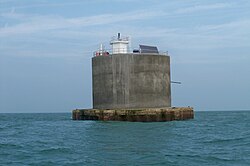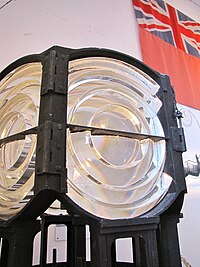Nab Tower
| Nab Tower | |
 The Nab Tower, Hampshire | |
|---|---|
| Location | |
| Grid reference: | SZ742858 |
| Location: | 50°40’3"N, 0°57’4"W |
| Characteristics | |
| Height: | 56 feet |
| Tower shape: | broad cylindrical tower faced with reinforced concrete |
| Tower marking: | unpainted tower, white light |
| Light: | Fl W 10s. |
| Intensity: | 2,850 candela |
| Focal height: | 56 feet |
| Range: | 12 nautical miles |
| Light source: | Vega LED lantern |
| History | |
| Built 1918 / 1920 | |
| First lit: | 1920 |
| Information | |
| Owned by: | Trinity House |
The Nab Tower is a tower in the Solent originally planned for anti-submarine protection in the Solent in the First World War, and now a lighthouse. After the Great War, the tower was sunk over the Nab Rocks east of the Isle of Wight to replace a lightship. Today it is a well-known landmark for sailors as it marks the deep-water eastern entry into the Solent.
History
During the First World War, the Admiralty designed eight towers, codenamed M-N, that were to be built and positioned in the Straits of Dover to protect allied merchant shipping from German U-boats. Designed by civilian Guy Maunsell, the towers were to be linked together with steel nets and armed with two 4-inch guns with the idea of closing the English Channel to enemy ships.
However, by the end of the war in 1918, only one such tower had been completed, at the time a cost of one million pounds, and was located at Shoreham Harbour, awaiting deployment. While another part-built tower would eventually be dismantled in 1924, there remained the completed metal cylinder 92 feet tall sitting on a raft of concrete.
In 1920 the completed tower was towed by two paddle-wheel tugs to the Nab rock, a rock in the deep-water approach to the eastern Solent and previously marked by a lightship. Buoyancy was provided by the honeycomb construction of the concrete base, creating 18 watertight compartments. When these were flooded, the structure sank and settled to rest at an angle of 3 degrees from vertical towards the northeast – a characteristic tilt which is obvious to this day.[1]
Initially, the tower had a single centrally-placed lamp containing an Osram gas-filled incandescent light bulb, which gave a single white flash every ten seconds, with a visible range of 16 nautical miles.[2] A fog horn was also installed, in a separate shed on the tower top. Later, the single light was replaced by a pair of small (fifth-order) revolving dioptric optics, each of which produced a single flash every 10 seconds;[3] they were mounted in small turrets on opposite sides of the tower: one shone red towards the north-west, the other shone white towards the south-east (their arcs overlapped, so that vessels approaching from seaward would see the red light as well as the white if their course took them too close to St Catherine's Point, approaching from the west, or Selsey Bill, approaching from the east).[4] In December 1935 a radio beacon was added.[5]
In 1938 a more powerful diaphone fog signal was installed (in place of the old fog horn), which gave one 2.5-second blast every minute.[6] It was synchronised with the radio beacon; by timing the delay between receiving the radio signal and the audible signal, vessels were able to calculate their distance from the tower.[7] The tower was equipped with a fog bell, as well as the diaphone,[8] which sounded one stroke every 7.5 seconds.
The Nab Tower was manned as a lighthouse, but also functioned as a Royal Navy signal station; and during Second World War it was equipped with a pair of Bofors 40 mm Automatic Gun to provide some defence to the Solent approach, and actually shot down several aircraft. The Royal Navy withdrew its personnel from the tower some time after the war, but the tower remained under Ministry of Defence ownership until 1984, when Trinity House acquired the freehold (they had previously taken over responsibility for the light itself from the Admiralty in 1929).[9][10]
The Nab Tower still functions as a lighthouse, but since 1983 it has been unmanned. That year, a helicopter pad was constructed on the tower and a new pre-fabricated lantern-tower was installed containing an automated acetylene lamp; as well as powering the lamp, acetylene gas drove the revolving mechanism for the lightweight Glass-reinforced plastic optic in which the lamp was set.[11] In 1995 the light was converted to solar power operation and a new Orga rotating beacon was installed in the lantern (later a Vega VRB-25 rotating beacon was used).[12]
Trinity House carried out a major refurbishment in 2013.
Wrecks
In November 1999, the merchant freighter Dole America, carrying a cargo of bananas and pineapples, hit the Nab. The ship was badly damaged and only avoided sinking by being run aground. The base of the tower suffered superficial and internal damage. The damage was repaired in 2001.
In popular culture
The tower was featured as the main setting of the 1951 Hammer thriller The Dark Light.
Outside links
| ("Wikimedia Commons" has material about Nab Tower) |
- Nab Tower Lighthouse: Trinity House
- Trinity House
- Images of the tower in 1961 (Imperial War Museum)
- Photos of ship after collision with Nab Tower
References
- ↑ Woodman, Richard; Wilson, Jane (2002). The Lighthouses of Trinity House. Bradford-on-Avon, Wilts.: Thomas Reed. pp. 96–97.
- ↑ "Light on the "Mystery Tower"". BEAMA Journal: A Monthly Review of Power and Engineering Progress 13. 1923.
- ↑ Jackson, Derrick (1975). Lighthouses of England and Wales. Newton Abbott, Devon: David & Charles. p. 66.
- ↑ Admiralty Chart, 1954
- ↑ Hansard, House of Commons vol.311 c.1502 5 May 1936 Directional Wireless (South Coast)
- ↑ List of Lights, Radio Aids, and Fog Signals: British Isles, English Channel and North Sea. Washington DC: U.S. Hydrographic Office. 1958.
- ↑ Renton, Alan (2001). Lost Sounds: The Story of Coast Fog Signals. Caithness, Scotland: Whittles. p. 147.
- ↑ Harold Taylor: Nab Tower Lighthouse, Part 1
- ↑ Millyard, Simon (Summer 2014). "Nab Tower Engineering Works 2013 – 2014". Flash (21): 4–5. https://www.trinityhouse.co.uk/asset/1318/download?1457365959. Retrieved 20 March 2019.
- ↑ Hansard, House of Commons vol.226 c.1674 19 March 1929 Army And Air Force (Annual) Bill
- ↑ Naish, John Michael (1985). Seamarks: Their History and Development. London: Stanford Maritime. p. 163.
- ↑ "Nab Tower". Trinity House. Trinity House. http://www.trinityhouse.co.uk/lighthouses/lighthouse_list/nab_tower.html.
| Lighthouses of Trinity House |
|---|
|
Great Britain: |
| Channel Islands and Gibraltar: Casquets • Europa Point • Les Hanois • Sark |

